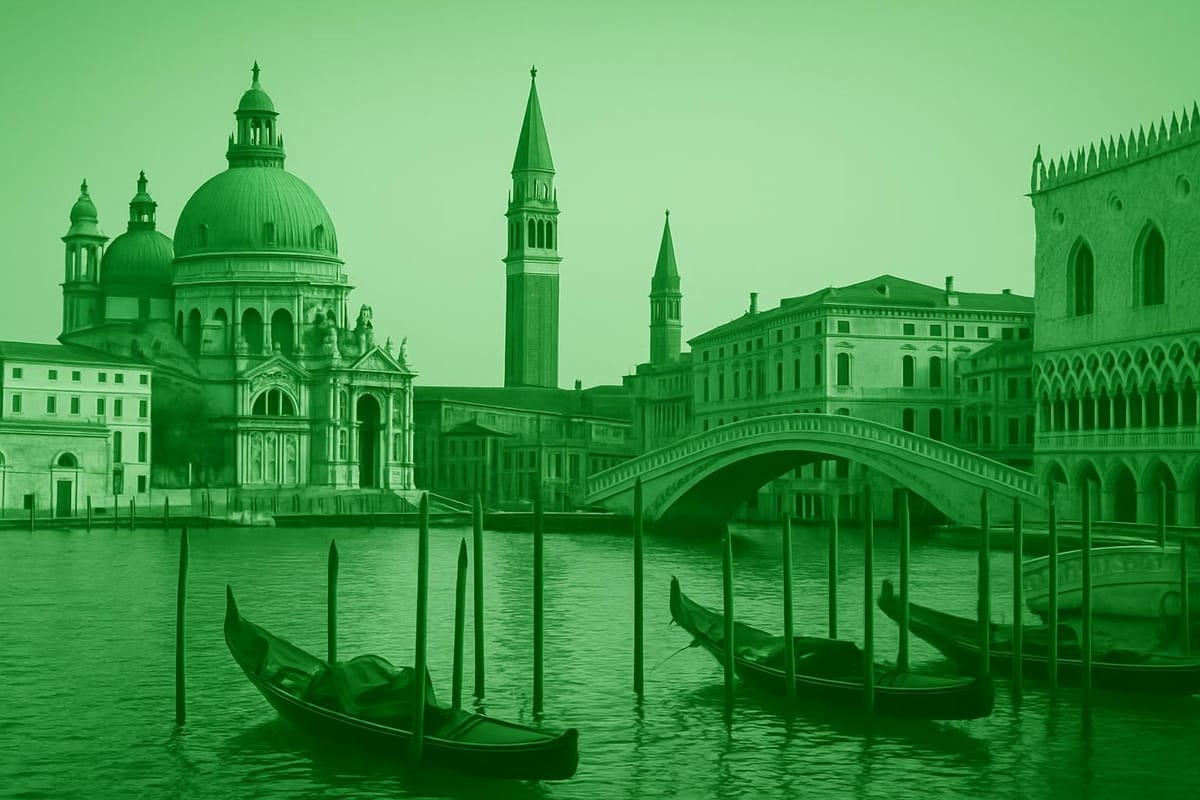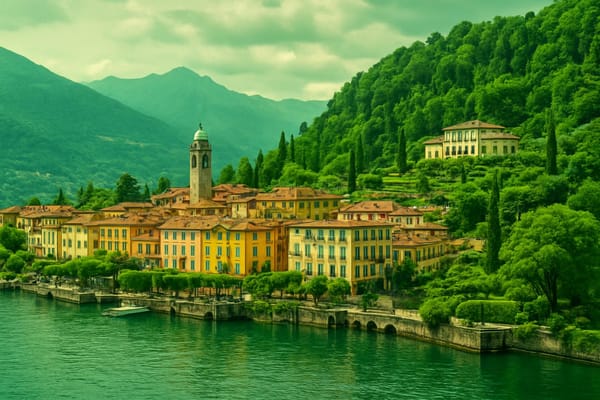Venice
Romantic gondola rides, canals, Rialto Bridge & St. Mark's Basilica - historic palaces & art.

Important things to know about Venice
Venice, Italy unfolds like a living poem, a city of canals where water replaces streets and every reflection doubles the sense of history; walking its narrow lanes or drifting along quiet waterways reveals a layered urban fabric shaped by salt, trade and craftsmanship. The lagoon that enfolds Venice is both protector and protagonist, its tides sketching rhythms for daily life while the pale facades of palazzi and the worn stone steps tell of centuries of architecture and adaptation to an aquatic environment. Smells of brackish water and baking bread mingle with the metallic tang of distant boats, creating an atmosphere that balances the practical pulse of a working city with the hushed hush of places that seem almost removed from modern time. Residents navigate a labyrinth of alleys, bridges and passageways where light pools and shadows shift, and small squares become stages for ordinary routines: market trade, conversation, laundry, and the quiet maintenance of homes and boats. Craft traditions-boatbuilding, glassmaking echoes in descriptions rather than named workshops-persist alongside contemporary life, contributing to a sense of continuity that makes Venice both timeless and unmistakably urban. The interplay of stone and water, old and new, public and intimate, gives the city a texture that is at once tactile and visual: peeling plaster, frescoed surfaces glimpsed through courtyards, and the rhythmic lapping of waves against foundations. To experience Venice is to sense a living organism shaped by environmental forces, cultural memory and everyday human resilience-a remote, fragile, and astonishingly vibrant urban center in the heart of northeastern Italy.
Sightseeing hot-spots in Venice
Venice in Italy is a uniquely enchanting destination where sightseeing becomes a journey through art, history and water. Floating along the famous Grand Canal by gondola or vaporetto, visitors encounter a continuous parade of palaces, bridges and churches whose façades reflect in the slow-moving water. The labyrinth of narrow alleys and sunlit squares invites travelers to wander aimlessly, discovering postcard-perfect scenes around every corner and capturing the romantic atmosphere that defines Venice travel.
At the heart of the city lies St. Mark's Square, home to the magnificent Basilica with its Byzantine mosaics and the imposing Doge's Palace, both essential stops for anyone interested in the art and political history of the Republic of Venice. The iconic Rialto Bridge spans the Grand Canal, offering one of the best vantage points for photographs and the bustle of market life. Museums and galleries throughout the city preserve masterpieces by masters of Venetian art and architecture, making Venice a must-see for culture seekers and those planning Venice attractions into their itinerary.
For optimal sightseeing in Venice, plan to explore at different times of day: morning light for photos, afternoon for museum visits, and evening to enjoy the quiet charm of the historic canals. Public water buses and private water taxis make it easy to reach major sites, while side canals reveal quieter neighborhoods and artisan shops. Whether you're focused on iconic landmarks or the pleasure of getting lost, Venice offers a travel experience where history, architecture and the magic of the lagoon converge into lasting memories.
Hotels to enjoy in Venice
Venice is a city where hotels in Venice often feel like living inside a painting, with many Venice hotels housed in restored Venetian palazzo overlooking the Grand Canal or tucked away near the iconic St. Mark's Square. Travelers searching for accommodation in Venice can choose from grand luxury properties that offer opulent rooms, historic frescoes and concierge-arranged gondola rides, to charming boutique hotels that emphasize local design and personalized service. For those on a budget, comfortable budget options and family-run pensions provide clean, centrally located bases for exploring the labyrinth of canals and bridges. The appeal of staying in Venice, Italy is not just the location but the rhythm of the city - waking to the sound of water taxis, stepping from a private dock onto cobbled streets, and enjoying a breakfast with a canal view as the morning light catches the façades.
Choosing the right hotel in this timeless city means balancing atmosphere, proximity and amenities; some visitors prioritize a romantic room facing a quiet canal while others seek a modern property with business services or family-friendly suites. Many Venice hotels highlight local experiences like culinary tours, seasonal festivals and historic tours that help guests connect with the city's culture. Whether you are driven by the desire to be steps from St. Mark's Square, to experience the best of Venetian cuisine, or to find a serene retreat after a day of sightseeing, Venice offers an unparalleled range of places to stay - each promising an intimate glimpse into the charm and history of Venice, Italy.
Restaurants to try in Venice
Venice is a dream for food lovers, and the restaurants in Venice offer an irresistible mix of tradition and innovation. Wander from a quiet campo to a bustling canal and you’ll find everything from humble bacari serving cicchetti to elegant Michelin-starred dining rooms with views over the lagoon. The best Venice restaurants balance fresh seafood, delicate risottos, and rich regional wines, showcasing authentic Venetian cuisine made with local ingredients like cuttlefish, sardines, and polenta. Whether you choose a canal-side trattoria in Dorsoduro or a hidden osteria near Rialto, the atmosphere-gondolas gliding past, the soft glow of lanterns, historic façades-turns every meal into a memorable experience that captures the spirit of Venice, Italy.
To truly enjoy dining in Venice, seek out places that focus on seasonality and simplicity, where the chef respects local fishing traditions and artisanal producers. Try small plates to savor more flavors: creamy baccalà mantecato, grilled branzino, or a plate of marinated anchovies paired with a crisp glass of Prosecco or a regional white. Look for cozy, family-run eateries for honest prices and warm hospitality, or book ahead for a special night at a refined restaurant with panoramic canal views. Exploring the culinary scene here is as much about the journey between eateries as the meals themselves-meandering alleys and scenic bridges leading you from one culinary discovery to the next, reinforcing why searching for the best restaurants of Venice remains a top travel priority for food-focused visitors.
Best shopping stops in Venice
Venice shopping is an unforgettable blend of art, history and craftsmanship where every canal-side boutique and backstreet atelier tells a story. Strolling from Rialto Market past the Rialto Bridge, travelers find an eclectic mix of Murano glass chandeliers, delicate Burano lace, and contemporary jewelry created by local designers. The city is famous for its handmade masks - a perfect Carnival keepsake - and for artisanal leather goods and footwear crafted in small workshops hidden in the sestieri of San Polo and Dorsoduro. For those seeking antiques and vintage finds, the narrow streets around Campo Santa Margherita and the quieter corners near San Marco conceal charming antique shops and independent galleries where collectors can discover rare prints, Venetian mirrors and restored furniture that capture the spirit of the lagoon.
Beyond high-end luxury boutiques, Venice shopping also thrives in lively markets and family-run studios where you can watch master glassblowers and mask makers at work. Food lovers should not miss the local delis selling regional specialties - from balsamic and olive oils to cicchetti-friendly snacks - while the Rialto food stalls brim with fresh seafood and produce that make excellent edible souvenirs. Whether you're searching for bespoke jewelry, unique home décor, or authentic souvenirs, exploring Venice on foot reveals a shopping experience rooted in centuries of tradition and innovation. Plan visits to artisan workshops, haggle respectfully at open-air stalls, and carry an eye for quality to bring home treasures reflecting true Venetian craftsmanship.
Nightlife highlights in Venice
Venice is famous by day for its canals, but the Venice nightlife truly comes alive as the sun sets over the Grand Canal. Strolling along the evening canals you’ll find intimate canal-side bars and traditional bacari where locals and visitors mingle over aperitivo and cicchetti - small plates that are an essential part of experiencing nightlife in Venice. The atmosphere shifts from the daytime tourist bustle to a softer, more romantic pace; bridges glow under street lamps, gondolas glide beneath ancient arches, and squares such as Campo Santa Margherita buzz with convivial energy. For those seeking a picture-perfect night, sunset views from a vaporetto or a quiet alleyway café offer memorable moments of Venetian charm, making Venice, Italy a top destination for evening exploration.
Beyond sipping spritz and sampling snacks, the cultural heartbeat of Venice continues after dark with live jazz, intimate music venues, and world-class performances at Teatro La Fenice. Small clubs and wine bars often host local bands and DJ sets, while art openings and late-night exhibitions add creative flair to the scene. Whether you prefer an elegant opera, a cozy bar with conversation, or wandering the moonlit canals, the diverse options ensure that the nightlife highlights of Venice cater to romantic evenings, cultural discoveries, and lively social nights alike.
Getting around in Venice
Venice's airport and train situation makes it one of the most unique transport hubs in Europe: most international flights arrive at Venice Marco Polo Airport (VCE) with easy shuttle buses and water connections to the historic centre, while budget airlines often use Treviso (TSF), a smaller airport with direct coaches to Venice; from either airport you can choose fast buses to Piazzale Roma or scenic water shuttles like Alilaguna and private water taxi services that deliver you straight into the lagoon. On land, the city is served by Venezia Santa Lucia station, where regional and high-speed trains from Milan, Rome and Florence pull in alongside the Grand Canal, and Venezia Mestre on the mainland acts as a major hub with frequent local trains and easier road access and parking. Travellers should plan transfers between airport shuttle, vaporetto and train schedules, allow extra time for luggage and peak-season queues, and consider the People Mover and ACTV buses for quick mainland-city links; whether you prefer the dramatic canal-side arrival by train or the waterborne approach from Marco Polo, Venice’s combined airport and rail network offers multiple convenient options to fit budgets, timing and unforgettable first impressions of the lagoon city.
Culture must-see's in Venice
Venice epitomizes a unique blend of history, art and waterbound charm where every narrow calle and grand canal tells a story. The city’s canals and iconic Gondolas create a living postcard, lined by Renaissance palazzi, Byzantine mosaics and baroque facades that define Venice architecture. Walking through St. Mark’s Square toward St. Mark’s Basilica and the Doge’s Palace reveals layers of power and devotion visible in gilded interiors, soaring domes and the famously photogenic Rialto Bridge. Museums and galleries across the city preserve masterpieces of Venetian art, while the quiet laneways and hidden courtyards reward exploration with unexpected views of the lagoon, classical sculptures and centuries-old frescoes that attract art lovers and cultural travelers interested in the best of Venice culture.
Beyond monuments, Venetian life pulses through traditions that make the city a perennial cultural destination. Annual celebrations such as the Carnival with ornate masks and the contemporary Biennale for art and architecture showcase both historic ritual and avant-garde creativity, while Teatro La Fenice continues to host world-class opera performances. Skilled artisans keep alive crafts like Murano glassmaking and Burano lace, and the culinary scene-from cicchetti bars to seafood-rich lagoon cuisine-completes the sensory experience of visiting. For those searching for things to do in Venice or looking to understand Venetian culture, the mosaic of festivals, museums, artisan workshops and historic sites offers a rich, searchable itinerary that feeds both curiosity and the desire for authentic cultural immersion.
History of Venice
The history of Venice is a unique story of human ingenuity, adaptation, and maritime ambition that began in the muddy salt lagoon where refugees from the collapsing Western Roman Empire sought safety from barbarian invasions. Over centuries, small island communities coalesced into a powerful city-state known as the Republic of Venice, whose government centered on the elected Doge and a complex system of councils. Strategic location on trade routes between East and West transformed Venice into a dominant maritime power, controlling commerce in spices, silk, and precious metals while establishing trading colonies and alliances across the Mediterranean and the Black Sea. The city’s distinctive urban fabric-built on wooden piles driven into the lagoon and threaded with canals instead of streets-enabled a thriving mercantile culture that spawned the famed Venetian Arsenal, an industrial-scale shipyard that produced galleys at unprecedented speed and efficiency. Byzantine, Gothic, and later Renaissance influences shaped Venice’s architecture and art; masterpieces in St. Mark’s Basilica and the palazzi along the Grand Canal reflect wealth accumulated through commerce and the city’s role as a cultural crossroads.
Venice’s history also includes dramatic turns: its pivotal role in the Crusades, especially the Fourth Crusade which altered the balance of power in the Eastern Mediterranean, and slow geopolitical decline as new Atlantic trade routes emerged after the Age of Discovery. By the late 18th century the independent Republic had weakened and was dissolved by Napoleon in 1797; subsequent Austrian rule and eventual incorporation into the Kingdom of Italy in 1866 marked Venice’s transition from an imperial sea power to a modern tourist and cultural center. Today the legacy of Venice’s past is visible in its conservation of art, architecture, and traditions, while contemporary challenges-rising seas, acqua alta, mass tourism, and preservation-shape debates about the city’s future. The enduring appeal of Venice’s history lies in its blend of innovation and beauty: a city literally built on water that influenced global trade networks, artistic movements like the Renaissance, and political models, continuing to captivate researchers, travelers, and anyone interested in the long arc of human civilization.



